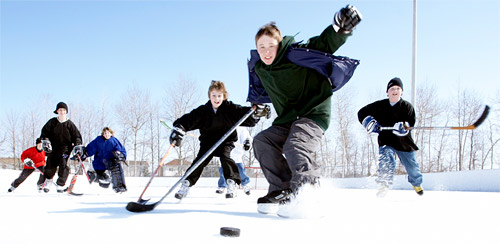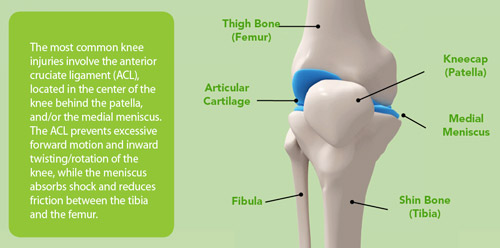The growth of organized amateur sports over the past 30 years has spawned an unexpected and unwanted increase in sports-related injuries. Many young athletes suffer sports-related injuries that can turn into lifelong problems. Here are some basic facts about knee injuries and how they are handled in the world of modern medicine. I am not passing judgment – just pointing out some facts.
The American Academy of Orthopedic Surgeons reported that in 2003, 9.5 million people visited orthopedic surgeons because of knee problems. By now, this staggering number is probably even higher, considering a greater number of children and adults are participating in athletics every year. The most common recommendation regarding knee injuries is to avoid the activities that take place when the knee is injured, such as activities that require stopping and starting or quickly changing directions. It is thought that these extreme forces on the knee can result in torn ligaments; however, they don’t result in torn ligaments in everyone, which means there could be some pre-existing contributing factors.
To learn why our knees are injured so frequently, it’s important to know how the knee works. The knee joint is composed of four bones: the femur, the tibia, the fibula and the patella (see image on facing page). Cartilage covers the joint and provides a smooth, lubricated gliding surface so the knee can move. The shape of the knee joint is stable, but to function properly, the ligaments have to be in good shape, too! Those ligaments include the anterior cruciate ligament (ACL), the posterior cruciate ligament (PCL), the medial collateral ligament (MCL) and the lateral collateral ligament (LCL).

While the ACL works as the main stabilizer when the knee is bent, the PCL works as the main stabilizer when the knee is extended. The collateral ligaments are used when you move side to side. The medial and lateral menisci are located within the joint and act as “shock absorbers” and also influence knee stability. The most commonly injured parts of the knee are the ACL and the medial meniscus. Tears of the meniscus usually take place during twisting, pivoting, or decelerating movements, or as a result of direct impact.
When you look for information regarding treatment of knee injuries, you will see two basic categories of medical care: surgical and nonsurgical. Surgical intervention has certainly improved over the past 20 years and typically involves arthroscopic surgery for severely sprained or ruptured ligaments or torn cartilage. The new procedures are far less invasive than techniques used many years ago, resulting in less scar tissue and faster recovery time. Nonsurgical intervention typically involves improving the stability of the knee joint with rehabilitative exercises, focusing on the quadriceps (thigh) muscles and the hamstrings. Bracing is also a common practice to enhance stability by limiting motion in the knee joint.
To summarize, the way knee injuries are handled in today’s world is to stop doing things that tear ligaments, like running, jumping, twisting and stopping quickly. If you do want to continue doing those things, the common recommendation is to get surgery or do rehab and put on a brace to limit motion in the joint. The resulting lack of motion will likely cause degenerative arthritis over the next 20-40 years, which will result in the need for a knee joint replacement.
OK, so where’s the good news? Simply put, a chiropractor has the ability to do a better job than that! Their knowledge of the foot, knee, hip and spine connection, combined with practical experience, affords an alternative to the “shoot the dice and hope for the best” theory. The first thing to understand is that healthy knee function is not possible without healthy foot function. The medical model of health care does not take that into consideration because the foot rarely presents itself as being painful. Even if the foot does hurt, treatment only takes care of the symptom and does not address abnormal joint function.
A vast majority of people, young and old, excessively pronate. This means that when the foot hits the ground, it flattens out or unlocks, rolling inward and creating a twisting stress up the leg and into the knee. These twisting stresses do three things to the knees: stretch the ACL, stretch and twist the medial meniscus, and inhibit contraction of the quadriceps muscle.
Every time we take a step, jump, pivot, stop quickly and run, those three things take place. A torn knee ligament is not a one-injury event; it is a multiple micro-injury event. These abnormal forces take place perhaps thousands of times, creating microtrauma to the support structures of the lower leg until the ligament fails catastrophically.
If thigh muscle weakness is one of the results of excessive pronation, doesn’t it make sense that the muscle loses its tone to a point that it can no longer stabilize the joint efficiently? Remember, muscle is the primary stabilizer; ligaments are secondary. If you weaken the muscle and traumatize the ligament a few thousand times, you have all the ingredients for the classic knee injury.
Common sense tells us to prevent the excessive damaging motions by supporting the foundational structures (your feet) so they function within the functional range of motion. Many chiropractors now evaluate the quality of the arches of the feet. If the arches aren’t supporting the legs and pelvis sufficiently, it can create stresses that lead to injury or joint wear and tear. It’s just like the foundation of your house; if it settles too much, it creates stress in other parts of the structure.
Take a proactive step to avoiding injuries and preserving the health of your knees, hips and spine. After all, you know what they say about “an ounce of prevention.” Ask your doctor for a thorough foot evaluation, particularly if you’re experiencing knee pain or participate in activities that put you at risk for a knee injury.

Brian Jensen, DC, is a graduate of the University of Nebraska and Palmer College of Chiropractic. He specializes in structural biomechanics and has been in practice for 17 years.